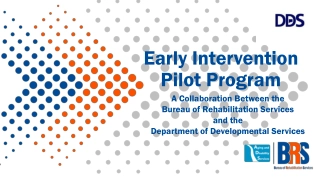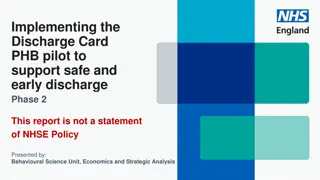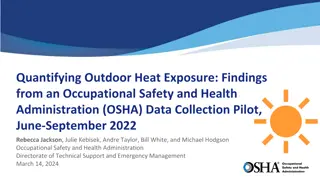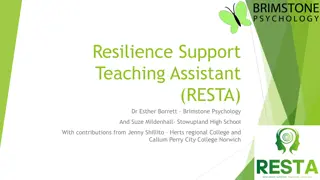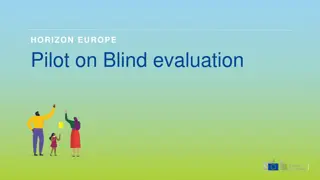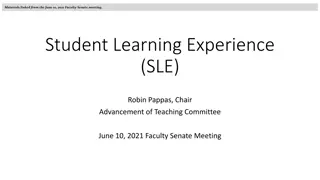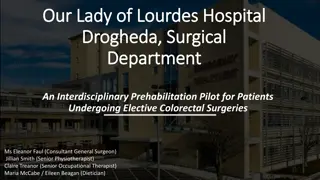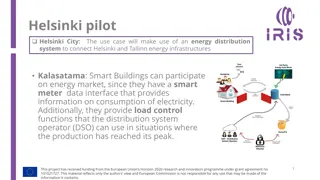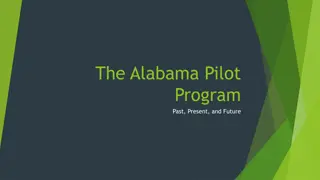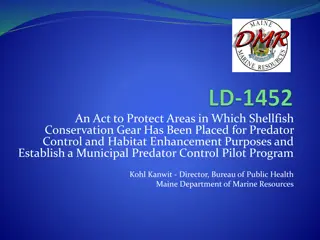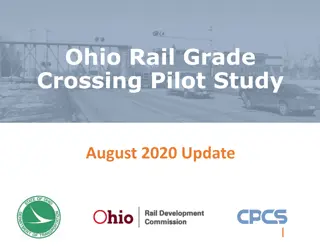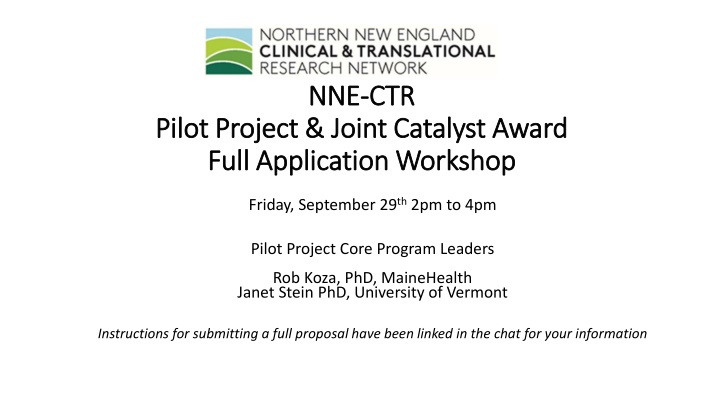
Pilot Projects Program at NNE-CTR for Clinical and Translational Research
Explore the Pilot Projects Program at NNE-CTR offering funding and support for clinical and translational research collaborations. Learn about the application process, key contacts, and submission timeline for new research initiatives. Join the upcoming workshop to understand how to submit a full proposal successfully.
Download Presentation

Please find below an Image/Link to download the presentation.
The content on the website is provided AS IS for your information and personal use only. It may not be sold, licensed, or shared on other websites without obtaining consent from the author. If you encounter any issues during the download, it is possible that the publisher has removed the file from their server.
You are allowed to download the files provided on this website for personal or commercial use, subject to the condition that they are used lawfully. All files are the property of their respective owners.
The content on the website is provided AS IS for your information and personal use only. It may not be sold, licensed, or shared on other websites without obtaining consent from the author.
E N D
Presentation Transcript
NNE NNE- -CTR CTR Pilot Project & Joint Catalyst Award Pilot Project & Joint Catalyst Award Full Application Workshop Full Application Workshop Friday, September 29th2pm to 4pm Pilot Project Core Program Leaders Rob Koza, PhD, MaineHealth Janet Stein PhD, University of Vermont Instructions for submitting a full proposal have been linked in the chat for your information
Pilot Projects Program Core Introduction Congratulations on being invited to submit a full proposal! Our Pilot Projects are designed to stimulate new collaborations and multidisciplinary partnerships between laboratory scientists, physician investigators, and rural practitioners looking to begin a career in clinical and translational research. We provide funding and professional support for clinical and translational research, from project development through completion, for NNE-CTR members.
Pilot Project Core Program Team Contacts Keep an eye out for communications from these people! Reach out, we re here to help! NNE-CTR Pilot Project Core Program Leads: Rob Koza, PhD, MaineHealth Robert.Koza@mainehealth.org Janet Stein PhD, University of Vermont Janet.Stein@med.uvm.edu NNE-CTR Administrative Program Managers: Meredith Oestreicher, MaineHealth meredith.oestreicher@mainehealth.org Shelia Clifford-Bova, University of Vermont sheila.clifford-bova@med.uvm.edu NNE-CTR Grant Specialist: Michele Locker, MaineHealth michele.locker@mainehealth.org www.med.uvm.edu/nne-ctr
Todays Session NNE-CTR Core Services Navigation Services Application Forms Section A: NIH Forms Section B: Budget Section C: Biosketch Section D: Research Plan Section E: Human Subjects and Vertebrate Animals Sections F, G and H: Collaborating site assurance, PI/PPL attestation and Checklist How to Submit Review Process Notification and JIT Phase Approvals Funding Mechanism NOTE: We will take time for questions after each section, please use the raise hand function versus the chat
Proposal Submission Timeline November 1st: Full application submission deadline February 26th: Recommendations for Funding Announced 5 PPP Research projects will be recommended 1 Gund Catalyst project will be recommended Around March 8th: Meeting w/Project Leads recommended for funding Discuss next steps, regulatory approvals, etc June 15th: Regulatory approvals and other JIT materials due July: Intended Project Start Date Based on the funding cycle of the NNE-CTR parent grant Subject to regulatory and NIGMS approval
Administrative Core The Administrative Core is the hub of the NNE-CTR. We connect all of our cores, institutions, and community partners across Vermont, New Hampshire, and Maine into one cohesive network. The result is an unparalleled wealth of expertise in clinical and translational research that we use to address local health challenges. As a multiple Principal Investigator program led by Drs. Cliff Rosen and Gary Stein, our network is leveraging decades of clinical and translational experience to guide network organization and engagement across northern New England. Admin Core Team Members: Dr. Cliff Rosen, Dr. Gary Stein (Co-PIs); Dr. Renee Stapleton, Dr. Tom Gridley (Program Coordinators); Sheila Clifford- Bova, Meredith Oestreicher (Administrative Program Managers)
Our Service Cores The Biostatistics, Epidemiology, & Research Design Core (BERD) supports NNE-CTR members to conduct the highest quality clinical and translational research. Our Research Navigators provide expert guidance and assistance with the research process, from study design all the way through to statistical analysis and reporting. BERD Core Team Members: Susan Santangelo, Peter Callas (Core Leads); Emmaline Ashe, Wendy Craig, Melissa Graham (Research Navigators); Jonathan Emery, Shamima Khan (Research Navigators/Biostatisticians); Derek Devine (Biostatistician)
Service Cores Continued Community Engagement & Outreach Core (CEO) Support communities in identifying their unique priorities for research and then help them share those priorities with investigators, healthcare organizations, and stakeholders Build a robust structure supporting engagement between communities and investigators Engage investigators in research to reduce health disparities and inequities across communities in our region Foster a culture of research that recognizes and welcomes community stakeholders' expertise across the translational research spectrum CEO Core Team Members: Jan Carney, Kathleen Fairfield (Core Leads); Elizabeth Woods, Emma DayBranch, Carrie Sullivan, Nancy Kaplan (Community Engagement Research Navigators); Charles MacLean, Neil Korsen (PCBRN Liaisons)
Service Cores Continued The Professional Development Core (PDC) helps connect members with opportunities both through the NNE-CTR and through our participating institutions by providing training, education, mentorship and networking. PDC Core Team Members: Kimberly Luebbers, Irwin Brodsky (Core Leads); Jennifer Holmes, Don Gage (Research Navigators); Ivette Emery (Curriculum Director); Charles Irvin (Mentorship Director)
Service Cores Continued The Translational Research Technologies Core (TRT) provides all NNE- CTR members with support for clinical and translational research through access to state-of-the-art tools and technologies. Through our partnerships with core facilities at MaineHealth (MH) and the University of Vermont (UVM), the highest quality current technologies are at your fingertips. The TRT Core also provides any interested members with education and guidance about current and emerging technologies relevant to their research objectives. TRT Core Team Members: Frances Carr, Aaron Brown (Core Leads)
Navigation Services What are Navigation Services? Differ by core, and in some cases by location Visit our website for details HERE
Navigation: Research Navigators Research Navigators from the BERD and PDC cores help to translate project ideas into measurable research. Research Design Grant Preparation Manuscript and Presentation Preparation REDCap Support Data Collection & Management Data Analysis Data Visualization Compliance and Procedure IRB and IACUC approvals Policy and regulatory Procedures
Navigators: Community Engagement Community Engagement and Outreach Research Navigators from the CEO core facilitate and encourage research that engages communities. They also: Conduct community needs assessments Connect researchers, clinicians, and communities with shared interests Educate communities about clinical and translational research Educate researchers about community priorities Facilitate collaboration between communities & institutions
Navigation Services Have you connected with a Navigator? What services are you looking for?
Application: Section A NIH Forms Signed Cover Page (PHS398 face page) Project summary, relevance, performance site (PHS398Facepage2) Additional Project/Performance Site Locations form (only needed if more than two sites) List of Senior/Key and Other Significant Contributors and human embryonic stem cells (PHS398 fp2 continued)
Form Approved Through 02/28/2023 OMB No. 0925-0001 LEAVE BLANK FOR PHS USE ONLY. Type Activity Review Group Department of Health and Human Services Public Health Services Grant Application Do not exceed character length restrictions indicated. Number Formerly Facepage Council/Board (Month, Year) Date Received 1. TITLE OF PROJECT (Do not exceed 81 characters, including spaces and punctuation.) 2. RESPONSE TO SPECIFIC REQUEST FOR APPLICATIONS OR PROGRAM ANNOUNCEMENT OR SOLICITATION (If Yes, state number and title) Number: Title: NO YES 3. PROGRAM DIRECTOR/PRINCIPAL INVESTIGATOR To be completed by the Pilot Project Lead s Institutional Official 3b. DEGREE(S) 3a. NAME (Last, first, middle) 3h. eRA Commons User Name 3c. POSITION TITLE 3e. DEPARTMENT, SERVICE, LABORATORY, OR EQUIVALENT 3d. MAILING ADDRESS (Street, city, state, zip code) 3f. MAJOR SUBDIVISION 3g. TELEPHONE AND FAX (Area code, number and extension) TEL: E-MAIL ADDRESS: FAX: See info in our FAQ on Who signs this form What if the project has more than one site What your UEI number is 4. HUMAN SUBJECTS RESEARCH 4a. Research Exempt If Yes, Exemption No. No Yes No Yes 4b. Federal-Wide Assurance No. 4c. Clinical Trial 4d. NIH-defined Phase III Clinical Trial No Yes No Yes 5a. Animal Welfare Assurance No. 8. COSTS REQUESTED FOR PROPOSED PERIOD OF SUPPORT 7b. Total Costs ($) 8a. Direct Costs ($) 10. TYPE OF ORGANIZATION 5. VERTEBRATE ANIMALS 6. DATES OF PROPOSED PERIOD OF SUPPORT (month, day, year MM/DD/YY) From 9. APPLICANT ORGANIZATION Name No Yes 7. COSTS REQUESTED FOR INITIAL BUDGET PERIOD 7a. Direct Costs ($) Through 8b. Total Costs ($) Public: Federal State Local Address Private: Private Nonprofit For-profit: Woman-owned General Socially and Economically Disadvantaged Small Business 11. ENTITY IDENTIFICATION NUMBER DUNS NO. Cong. District 12. ADMINISTRATIVE OFFICIAL TO BE NOTIFIED IF AWARD IS MADE Name 13. OFFICIAL SIGNING FOR APPLICANT ORGANIZATION Name Title Title Address Address Tel: FAX: Tel: FAX: E-Mail: E-Mail: SIGNATURE OF OFFICIAL NAMED IN 13. (In ink. Per signature not acceptable.) DATE 14. APPLICANT ORGANIZATION CERTIFICATION AND ACCEPTANCE: I certify that the statements herein are true, complete and accurate to the best of my knowledge, and accept the obligation to comply with Public Health Services terms and conditions if a grant is awarded as a result of this application. I am aware that any false, fictitious, or fraudulent statements or claims may subject me to criminal, civil, or administrative penalties.
Program Director/Principal Investigator (Last, First, Middle): PROJECT SUMMARY (See instructions): Project Summary, Relevance Performance Sites Project Summary describe the overall project, including aims and outcomes. Relevance in no more than three sentences, briefly describe in lay language the impact of the project on public health. RELEVANCE (See instructions): Project Performance Sites the first site should be the site of the Project Lead. If there are collaborating sites, fill in for all collaborating sites See FAQ for questions on UEI number PROJECT/PERFORMANCE SITE(S) (if additional space is needed, use Project/Performance Site Format Page) Project/Performance Site Primary Location Organizational Name: DUNS: Street 1: City: Province: Project/Performance Site Congressional Districts: Additional Project/Performance Site Location Organizational Name: DUNS: Street 1: City: Province: Project/Performance Site Congressional Districts: Street 2: County: State: Country: Zip/Postal Code: Street 2: County: State: Country: Zip/Postal Code:
Program Director/Principal Investigator (Last, First, Middle): Additional Sites, if Needed Use only if additional space is needed to list additional project/performance sites. Additional Project/Performance Site Location Organizational Name: DUNS: Street 1: City: Province: Street 2: County: State: Country: Zip/Postal Code: Project/Performance Site Congressional Districts: Additional Project/Performance Site Location Organizational Name: DUNS: Street 1: City: Province: Street 2: County: State: Country: Zip/Postal Code: Project/Performance Site Congressional Districts: Additional Project/Performance Site Location Organizational Name: DUNS: Street 1: City: Province: Street 2: County: State: Country: Zip/Postal Code: Project/Performance Site Congressional Districts: Additional Project/Performance Site Location Organizational Name: DUNS: Street 1: City: Province: Street 2: County: State: Country: Zip/Postal Code: Project/Performance Site Congressional Districts: Additional Project/Performance Site Location Organizational Name: DUNS: Street 1: City: Province: Street 2: County: State: Country: Zip/Postal Code: Project/Performance Site Congressional Districts:
Program Director/Principal Investigator (Last, First, Middle): Senior/Key Page SENIOR/KEY PERSONNEL. See instructions. Use continuation pages as needed to provide the required information in the format shown below. Start with Program Director(s)/Principal Investigator(s). List all other senior/key personnel in alphabetical order, last name first. Name eRA Commons User Name Organization Role on Project List the Pilot Project Lead as senior/key, as well as Co-Leads at collaborating sites. Mentors or collaborators who are not giving measurable time should be listed as Other Significant Contributors. OTHER SIGNIFICANT CONTRIBUTORS Name Organization Role on Project Project staff such as data analysts, technicians, research coordinators, and research assistants, are not senior key or significant contributors. They are listed and described in the budget and budget justification. Human Embryonic Stem Cells If the proposed project involves human embryonic stem cells, list below the registration number of the specific cell line(s) from the following list: https://grants.nih.gov/stem_cells/registry/current.htm.Use continuation pages as needed. No Yes If a specific line cannot be referenced at this time, include a statement that one from the Registry will be used. Cell Line Don t forget to check YES or NO to Embryonic Cells!
Application pieces: Section B Budget Use the budget template developed for the NNE CTR Pilots to provide a detailed budget for each site, and a cumulative total Budget Justification from each site included in the budget template See FAQ for questions on who to go to for help with budget This is not a Navigator! Meredith or Sheila can help point you in the right direction
Budget: Basic Guidelines Direct costs up to 40k Use your own federally negotiated indirect rate not to exceed 72% Personnel No salary support for Faculty members, including PPL Support for research coordinators, assistants, tech staff, stats, analysts etc. Travel Travel must be related to the conduct of the research Presentations and/or attendance at a conference is not allowed Equipment and Software 3k cap on equipment, unless pre-approved, refer to instructions for more details Consultants Supplies Other Meals for meetings outside of travel reimbursements for per diem meals are not allowable under federal grants, per NIH policy.
Application Pieces: Section C Biosketch NIH Biographical Sketches of all Senior/Key Personnel in one combined PDF First biosketch in combined file should be Pilot Project Lead Current NIH format is required Instructions, template and example on our website Pilot Project Lead needs an era commons ID if selected for funding Done by home institution
Application Pieces: Section D Research Plan Include the following in one combined PDF: Introduction (if applicable) (1 page limit). Specific Aims (1 page limit) Research Strategy (6 page limit) References/Bibliography (no page limit) Letters of Support, if applicable
Specific Aims One Page Limit State concisely the goals of the proposed research and summarize the expected outcome(s), including the impact that the results of the proposed research will exert on the research field(s) involved. List succinctly the specific objectives of the research proposed, e.g., to test a stated hypothesis, create a novel design, solve a specific problem, challenge an existing paradigm or clinical practice, address a critical barrier to progress in the field, or develop new technology.
Research Strategy Six page limit, include Significance and Background literature review, premise, importance of subject Hypotheses and Impact Innovation Statement Approach to include the study design for each aim with rationale and method, Data collection method and plan for analysis (assays, statistical methods, bioinformatics). Outcomes and Future Directions. Bibliography/References NOT counted in 6 page limit
Research Plan: General Tips Read all the instructions carefully for application guidelines. Do not exceed the page limit nor use small font or narrow margins. There should be no page numbers, headers or footers. Use basic English and avoid jargon. Make sure your prose is organized and clear without typographical errors. Remember that your audience, the reviewers, will be inherently skeptical and may include experts in your field, or individuals who are smart but know little about your particular field. Your application must appeal to both of these types of reviewers. Never assume that your reviewers will intrinsically appreciate or understand what you intend. Be explicit.
Research Plan: General Tips Continued Do not put information in the wrong sections. Make sure all acronyms are spelled out when used initially. Include section headings and breaks in the writing. Repeat important points at several places in the application. Include well designed flow diagrams, charts, and figures. Make sure these are well labeled. Make sure your citations are complete. Have an outside reader review the application for clarity and consistency. Your goal is to get your audience excited about your research. Let your enthusiasm be reflected in your proposal. More on the review process coming up
Application Pieces: Section E Human Subjects, Clinical Trials and Vertebrate Animals Vertebrate Animal section, if applicable Human Subjects and Clinical Trials form, if applicable Template provided Tip Sheet provided on the website Note, the format will look different, but it is the same information being gathered
Application Pieces: Section E: HSCT USE YOUR NAVIGATOR TO HELP! Is it considered human subjects? if using de-identified specimens not collected for the study (i.e. from the Biobank) and investigators cannot know the identity, it may NOT be considered research with human subjects (get determination from IRB); if this is the case, a justification must be included. Is it exempt? Which exemption? Navigator to help and applicant to ask IRB prior to submission. Exemption must be justified Clinical Trial (answer yes to all four clinical trial questions) NOTE: if a clinical trial, there are additional terms that are included in the NOA if funded and Pilot Lead has additional responsibilities. If a Clinical Trial, Sections 1-4 to be filled out Single IRB: required when more than one site is conducting the same protocol and research is NOT exempt; one IRB must be designated to review/approve for all sites. Inclusion Enrollment Table or Planned Enrollment Table required (except if Exemption 4); must break down gender and ethnicity estimates Description of risks and protection measures; inclusion of all ages, women, minorities; data safety monitoring plan
Application Pieces: Sections F, G and H Collaborating site assurances Additional sites Institutional Official sign off PI (PPL) Attestation states your agreement to: Accept responsibility for scientific conduct of the project Provide the required progress reports Comply with the NNE-CTR terms and conditions outlined in the request for applications. Any publication, poster or presentation resulting from this research project will cite the NNE-CTR award U54GM115516 and comply with the NIH Public Access Policy. Checklist Indicates all sections are complete and uploaded
Letters of Support Optional These may include letters from: Hospital or Practice Group Leader Dean Chair Significant Contributor Consultant Any Personnel listed in budget, project leads and co-leads do not need to provide LOS
How to submit Pilot Projects Program Research Grants Individual Link sent via REDCap All sections A-G uploaded as PDFs Please use Required Naming Conventions! Gund Catalyst Program Grants Use same forms as PPP Research Grants No REDCap link Email sections as PDFs to Sheila Clifford-Bova
Review Committee Applications will be reviewed by a Pilot Project Program Review Committee based on NIH scoring criteria (to follow) Reviewers are within the NNE-CTR network from Maine, Vermont and collaborating health network and partner organizations Each application will be assigned two to three reviewers Review Committee will meet in January to discuss applications
Review Process Section 1 Significance Does the project address an important problem or a critical barrier to progress in the field? Is there a strong scientific premise for the project? If the aims of the project are achieved, how will scientific knowledge, technical capability, or clinical practice be improved? How will successful completion of the aims change the concepts, methods, technologies, treatments, services, or preventative interventions that drive this field?
Review Process Section 2 Investigators Do the Pilot Project Leads, Collaborators and other researchers have appropriate experience and expertise for the proposed work? If Early Stage Investigators or New Investigators, do they have appropriate experience and training? If established, have they demonstrated an ongoing record of accomplishments that have advanced their field(s)?
Review Process Section 3 Innovation Does the proposal challenge and seek to shift current research or clinical practice paradigms by utilizing novel theoretical concepts, approaches, methodologies, or instrumentation?
Review Process Section 4 Approach Are the overall strategy, methodology, and analyses well-reasoned and appropriate to accomplish the Specific Aims of the project? Have the investigators presented strategies to ensure a robust and unbiased approach, as appropriate for the work proposed? Are potential problems, alternative strategies, and benchmarks for success presented? Is the approach feasible for one year? (2 years for the Catalyst Award) If the project is in the early stages of development, will the strategy establish feasibility, and will particularly risky aspects be managed?
Review Process Section 5 Environment Will the scientific environment in which the work should be done contribute to the probability of success? Are the institutional support, equipment and other intellectual, technological, and physical resources available to the investigators adequate for the project proposed? Will the project utilize and benefit from unique features of the NNE- CTR scientific environment, subject populations, or collaborative arrangements?
Review Process Reviewers are asked to determine if the HSCT or Vertebrate Animals sections are acceptable, or not acceptable. If deemed not acceptable , but otherwise score well, a project may move forward, but will not be awarded until concerns are adequately addressed HUMAN SUBJECTS CRITERIA Have the investigators presented adequate plans to address relevant biological variables, such as sex, for studies in human subjects? Are there adequate plans to include women, minorities and individuals across the lifespan? Are there adequate plans to address: The risk to subjects and protection from risks; For clinical trials, data and safety monitoring plan, data analysis and timeline for results; If research is exempt, is there an acceptable justification for the exemption? VERTEBRATE ANIMALS CRITERIA Are all four points adequately addressed for use of vertebrate animals?
Notification and Just in Time (JIT) Phase Notifications of recommendations to fund Includes an Administrative Review Revisions, regulatory approvals and human subjects certifications will be due by specific date Continue to use navigators as needed
Approvals After JIT documents have been submitted and accepted Proposal goes to EAC for approval Proposal goes to NIGMS for final approval Project work may start after NIGMS approval is received NO PRE SPENDING!
Funding Mechanism Award letter sent to PPL within two days upon notification of NIGMS approval Please review award letter carefully Subcontract to follow (if applicable)
Final Questions? Thank you for joining, and good luck on your proposal!
Pilot Project Core Program Team Contacts NNE-CTRPilot Project Core Program Leads: Rob Koza, PhD, MaineHealth Robert.Koza@mainehealth.org Janet Stein PhD, University of Vermont Janet.Stein@med.uvm.edu NNE-CTR Administrative Program Managers: Meredith Oestreicher, MaineHealth meredith.oestreicher@mainehealth.org Shelia Clifford-Bova, University of Vermont sheila.clifford-bova@med.uvm.edu NNE-CTR Grant Specialist: Michele Locker, MaineHealth michele.locker@mainehealth.org www.med.uvm.edu/nne-ctr

